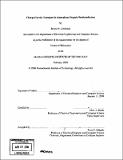Charge-carrier transport in amorphous organic semiconductors
Author(s)
Limketkai, Benjie, 1982-
DownloadFull printable version (8.753Mb)
Other Contributors
Massachusetts Institute of Technology. Dept. of Electrical Engineering and Computer Science.
Advisor
Marc A. Baldo.
Terms of use
Metadata
Show full item recordAbstract
Since the first reports of efficient luminescence and absorption in organic semiconductors, organic light-emitting devices (OLEDs) and photovoltaics (OPVs) have attracted increasing interest. Organic semiconductors have proven to be a promising material set for novel optical and/or electrical devices. Not only do they have the advantage of tunable properties using chemistry, but organic semiconductors hold the potential of being fabricated cheaply with low temperature deposition on flexible plastic substrates, ink jet printing, or roll-to-roll manufacturing. These fabrication techniques are possible because organic semiconductors are composed of molecules weakly held together by van der Waals forces rather than covalent bonds. Van der Waals bonding eliminates the danger of dangling bond traps in amorphous or polycrystalline inorganic films, but results in narrower electronic bandwidths. Combined with spatial and energetic disorder due to weak intermolecular interactions, the small bandwidth leads to localization of charge carriers and electron-hole pairs, called excitons. Thus, the charge-carrier mobility in organic semiconductors is generally much smaller than in their covalently-bonded, highly-ordered crystalline semiconductor counterparts. Indeed, one major barrier to the use of organic semiconductors is their poor charge transport characteristics. Yet this major component of the operation of disordered organic semiconductor devices remains incompletely understood. This thesis analyzes charge transport and injection in organic semiconductor materials. A first-principles analytic theory that explains the current-voltage characteristics and charge-carrier mobility for different metal contacts and organic semiconductor materials over a wide range of temperatures, carrier densities, and electric field strengths will be developed. (cont) Most significantly, the theory will enable predictive models of organic semiconductor devices based on physical material parameters that may be determined by experimental measurements or quantum chemical simulations. Understanding charge transport and injection through these materials is crucial to enable the rational design for organic device applications, and also contributes to the general knowledge of the physics of materials characterized by charge localization and energetic disorder.
Description
Thesis (Ph. D.)--Massachusetts Institute of Technology, Dept. of Electrical Engineering and Computer Science, 2008. Includes bibliographical references (p. 101-106).
Date issued
2008Department
Massachusetts Institute of Technology. Department of Electrical Engineering and Computer SciencePublisher
Massachusetts Institute of Technology
Keywords
Electrical Engineering and Computer Science.